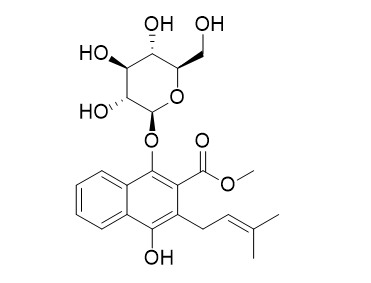1,4-Dihydroxy-2-carbomethoxy-3-prenylnaphthalene-1-O-beta-glucopyranoside
1,4-Dihydroxy-2-carbomethoxy-3-prenylnaphthalene-1-O-beta-glucopyranoside may have DNA topoisomerases I and II inhibitory activity and cytotoxicity.
Inquire / Order:
manager@chemfaces.com
Technical Inquiries:
service@chemfaces.com
Tel:
+86-27-84237783
Fax:
+86-27-84254680
Address:
1 Building, No. 83, CheCheng Rd., Wuhan Economic and Technological Development Zone, Wuhan, Hubei 430056, PRC
Providing storage is as stated on the product vial and the vial is kept tightly sealed, the product can be stored for up to
24 months(2-8C).
Wherever possible, you should prepare and use solutions on the same day. However, if you need to make up stock solutions in advance, we recommend that you store the solution as aliquots in tightly sealed vials at -20C. Generally, these will be useable for up to two weeks. Before use, and prior to opening the vial we recommend that you allow your product to equilibrate to room temperature for at least 1 hour.
Need more advice on solubility, usage and handling? Please email to: service@chemfaces.com
The packaging of the product may have turned upside down during transportation, resulting in the natural compounds adhering to the neck or cap of the vial. take the vial out of its packaging and gently shake to let the compounds fall to the bottom of the vial. for liquid products, centrifuge at 200-500 RPM to gather the liquid at the bottom of the vial. try to avoid loss or contamination during handling.
J Nat Med.2020, 74(1):65-75
Plants (Basel).2020, 9(11):1422.
Antioxidants (Basel).2024, 13(8):951.
Chem Biol Interact.2024, 394:110995.
Antioxidants (Basel).2019, 8(8):E307
J Cell Mol Med . 2023, jcmm.17954.
Plant Sci.2021, 313:111069.
Pak J Pharm Sci.2023, 36(1):51-57.
Int J Mol Sci.2024, 25(20):11227.
Anal Bioanal Chem.2023, 415(9):1641-1655.
Related and Featured Products
Planta Med. 2012 Jan;78(2):177-81.
Constituents with DNA topoisomerases I and II inhibitory activity and cytotoxicity from the roots of Rubia cordifolia.[Pubmed:
21979931 ]
METHODS AND RESULTS:
Activity-directed isolation of the ethyl acetate fraction from the roots of Rubia cordifolia resulted in the identification of a new anthraquinone, 1,3,6-trihydroxy-2-hydroxymethyl-9,10-anthraquinone-3- O- α- L-rhamnopyranosyl-(1 → 2)- β-D-(6'-O-acetyl)-glucopyranoside (1), two new dihydronaphtoquinones,
1,4-Dihydroxy-2-carbomethoxy-3-prenylnaphthalene-1-O-beta-glucopyranoside (2) and mollugin-1-O- β- D-glucopyranoside (3), and a new monoterpenoid, 3 R,3a S,4 R,6a R-3,4,6-tris(hydroxymethyl)-3,3a,4,6a-tetrahydro-2 H-cyclopenta[ B]furan-2-one (4), together with nine known compounds (5-13).
CONCLUSIONS:
The structures of these compounds were elucidated on the basis of spectroscopic evidence. In addition, their DNA topoisomerases I and II inhibitory activity and cytotoxicity were measured.



